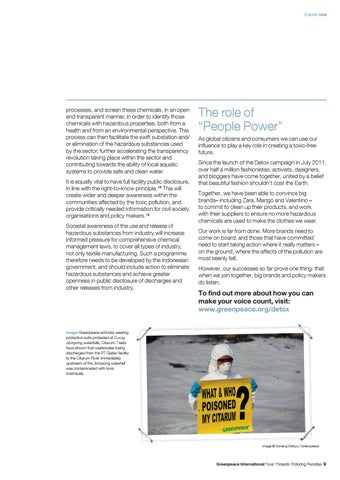chapter one
processes, and screen these chemicals, in an open and transparent manner, in order to identify those chemicals with hazardous properties, both from a health and from an environmental perspective. This process can then facilitate the swift substation and/ or elimination of the hazardous substances used by the sector, further accelerating the transparency revolution taking place within the sector and contributing towards the ability of local aquatic systems to provide safe and clean water. It is equally vital to have full facility public disclosure, in line with the right-to-know principle.18 This will create wider and deeper awareness within the communities affected by the toxic pollution, and provide critically needed information for civil society organisations and policy makers.19 Societal awareness of the use and release of hazardous substances from industry will increase informed pressure for comprehensive chemical management laws, to cover all types of industry, not only textile manufacturing. Such a programme therefore needs to be developed by the Indonesian government, and should include action to eliminate hazardous substances and achieve greater openness in public disclosure of discharges and other releases from industry.
The role of “People Power” As global citizens and consumers we can use our influence to play a key role in creating a toxic-free future. Since the launch of the Detox campaign in July 2011, over half a million fashionistas, activists, designers, and bloggers have come together, united by a belief that beautiful fashion shouldn’t cost the Earth. Together, we have been able to convince big brands– including Zara, Mango and Valentino – to commit to clean up their products, and work with their suppliers to ensure no more hazardous chemicals are used to make the clothes we wear. Our work is far from done. More brands need to come on board, and those that have committed need to start taking action where it really matters – on the ground, where the affects of the pollution are most keenly felt. However, our successes so far prove one thing: that when we join together, big brands and policy makers do listen.
To find out more about how you can make your voice count, visit: www.greenpeace.org/detox
image Greenpeace activists wearing protective suits protested at Curug Jompong waterfalls, Citarum. Tests have shown that wastewater being discharged from the PT Gistex facility to the Citarum River immediately upstream of the Jompong waterfall was contaminated with toxic chemicals.
image © Donang Wahyu / Greenpeace
Greenpeace International Toxic Threads: Polluting Paradise 9
